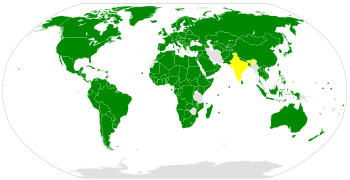United Nations Convention Against Torture facts for kids
| Convention Against Torture and Other Cruel, Inhuman or Degrading Treatment or Punishment | |
|---|---|

states parties
states that have signed, but not ratified states that have not signed |
|
| Type | Human rights convention |
| Drafted | 10 December 1984 |
| Signed | 4 February 1985 |
| Location | New York |
| Effective | 26 June 1987 |
| Condition | 20 ratifications |
| Signatories | 83 |
| Parties | 173 |
| Depositary | UN Secretary-General |
| Languages | Arabic, Chinese, English, French, Russian and Spanish |
The Convention Against Torture (also known as the United Nations Convention Against Torture or UNCAT) is an important international agreement. It was created by the United Nations. Its main goal is to stop torture and other very bad treatment from happening anywhere in the world. This includes cruel, inhuman, or degrading treatment or punishment.
This agreement makes sure that countries that sign it must work to prevent torture. They must do this in any area they control. It also says that countries cannot send people to another country if there's a good reason to believe they will be tortured there.
The United Nations General Assembly agreed on the text of this convention on December 10, 1984. It officially started on June 26, 1987, after 20 countries had agreed to follow it. Because of this, June 26 is now known as the International Day in Support of Victims of Torture. This day honors the convention and helps people remember its importance. Since it began, the rule against torture has become a widely accepted international law. By April 2022, 173 countries had joined this important convention.
Contents
What is the Convention Against Torture?
The Convention Against Torture is set up like other big human rights agreements. It has an introduction and 33 articles, which are like rules or sections. These are split into three main parts.
Part I: Stopping Torture and Bad Treatment
This part (Articles 1–16) explains what torture is. It also makes countries promise to take strong steps to stop any acts of torture. This applies to any place they control.
- Making Torture a Crime: Countries must make torture a criminal offense in their own laws (Article 4).
- Investigating Torture: If someone says torture happened, countries must quickly look into it (Articles 12 and 13).
- Help for Victims: People who have been tortured, or their families, must have the right to get help or money for what happened (Article 14).
- No Torture Evidence: Courts cannot use any information or evidence that was gotten through torture (Article 15).
- Protecting People: Countries cannot send people away if there's a strong chance they will be tortured in the new place (Article 3).
- Training and Rules: Countries need to train their police and other public workers about the rule against torture (Article 10). They also need to check their rules for questioning people to make sure torture is prevented (Article 11).
- Preventing Other Bad Treatment: This part also says countries must prevent other cruel, inhuman, or degrading treatment. They must investigate any claims of such treatment (Article 16).
Part II: Checking How Countries Follow the Rules
This part (Articles 17–24) talks about how the convention is checked. It explains how countries report on their progress.
- Committee Against Torture: It creates a group called the Committee Against Torture (Article 17). This committee can look into claims of widespread torture (Article 20).
- Solving Problems: This part also sets up ways for countries to solve disagreements with each other about the convention (Article 21). It also lets people complain to the committee if a country breaks the rules (Article 22).
Part III: How the Convention Works
This part (Articles 25–33) explains how countries can officially join the convention. It also covers how the convention can be changed later on. It includes a way for countries to settle disagreements through a process called arbitration (Article 30).
See also
 In Spanish: Convención contra la tortura y otros tratos o penas crueles, inhumanas o degradantes para niños
In Spanish: Convención contra la tortura y otros tratos o penas crueles, inhumanas o degradantes para niños

